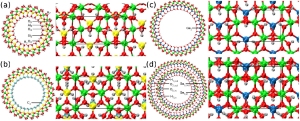As the cost of producing conventional energy sources continues to grow, the role photocatalysts play in energy conversion technologies becomes more important. Improving the efficiency of photocatalysts has been active area of research for many years, but faces many problems, including understanding their atomic composition, structure and dynamics. The high cost of trying to understand these factors experimentally has led researchers to instead model photocatalysts, reactants and their interfaces in a given medium.

Top and side view of the optimized (a) SW-AlSi24, (b) SW-AlSi28-Me, (c) SW-AlGe36 and (d) DW-AlGe36,54 Imo NTs. © 2016 IOP Publishing Ltd
This is exactly what E Poli et al have done in J. Phys.: Condens. Matter 28 074003. As part of a wider special issue looking at how theory and modelling can help understand solar energy materials, the researchers have used density functional theory to study the optical and electronic properties, as well as the effects of interacting water molecules on the well studied imogolite nanotubes. Using three different density functionals the authors are able to provide insight into the behavior of a number of imogolite nanotubes.
 This work is licensed under a Creative Commons Attribution 3.0 Unported License. Thumbnail image (adapted) and image used in post: E Poli et al 2016 J. Phys.: Condens. Matter 28 074003. Copyright IOP Publishing 2016.
This work is licensed under a Creative Commons Attribution 3.0 Unported License. Thumbnail image (adapted) and image used in post: E Poli et al 2016 J. Phys.: Condens. Matter 28 074003. Copyright IOP Publishing 2016.
Categories: Journal of Physics: Condensed Matter

 Advanced capabilities for materials modelling with Quantum ESPRESSO
Advanced capabilities for materials modelling with Quantum ESPRESSO  Scanning Probe Microscopy provides new perspectives for chemistry on surfaces and beyond
Scanning Probe Microscopy provides new perspectives for chemistry on surfaces and beyond